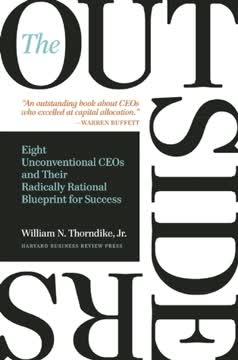نکات کلیدی
1. مدیریت سرمایه بلندمدت: صعود و سقوط یک غول صندوق پوشش ریسک
"در کمتر از چهار سال، سرمایهگذاری در این صندوق چهار برابر شده بود، قبل از محاسبه هزینههای شرکا."
صعود شهابوار: مدیریت سرمایه بلندمدت (LTCM) در سال 1994 توسط جان مریوتر، یک معاملهگر سابق سالومون برادرز، به همراه اقتصاددانان برنده جایزه نوبل مایرون اسکولز و رابرت مرتون تأسیس شد. این صندوق از مدلهای ریاضی پیچیده برای بهرهبرداری از اختلافات کوچک قیمتی در بازارهای اوراق قرضه استفاده میکرد.
موفقیت بیسابقه: سالهای اولیه LTCM با بازدهی فوقالعادهای همراه بود:
- 1994: بازدهی 28% (20% پس از کسر هزینهها)
- 1995: بازدهی 59% (43% پس از کسر هزینهها)
- 1996: بازدهی 57% (41% پس از کسر هزینهها)
سقوط چشمگیر: در سال 1998، یک سری شوکهای بازار، از جمله بحران مالی روسیه، منجر به زیانهای عظیمی برای LTCM شد. این صندوق در کمتر از چهار ماه 4.6 میلیارد دلار از دست داد و نیاز به یک بسته نجات 3.6 میلیارد دلاری به رهبری فدرال رزرو برای جلوگیری از یک بحران مالی سیستماتیک داشت.
2. خطرات اهرم بیش از حد در بازارهای مالی
"در پایان سال 1995، اهرم آن 28 به 1 بود."
بازدهی و ریسکهای تقویتشده: LTCM از اهرم عظیمی برای افزایش سود خود از اختلافات کوچک قیمتی استفاده میکرد. در اوج خود، این صندوق داشت:
- 4.7 میلیارد دلار سرمایه
- 129 میلیارد دلار دارایی
- بیش از 1 تریلیون دلار در معرض مشتقات اسمی
مقیاس بیسابقه: نسبتهای اهرمی LTCM بهطور قابلتوجهی از استانداردهای صنعت فراتر رفت، که آن را بهطور استثنایی در برابر نوسانات بازار آسیبپذیر کرد. با چرخش بازارها علیه موقعیتهای LTCM، این اهرم زیانها را تقویت کرد و به سرعت پایه سرمایه صندوق را فرسایش داد.
تهدید سیستماتیک: اندازه عظیم و ارتباطات گسترده صندوق با مؤسسات مالی بزرگ به این معنا بود که شکست احتمالی آن خطر قابلتوجهی برای سیستم مالی گستردهتر ایجاد میکرد و باعث شد فدرال رزرو بسته نجات را ترتیب دهد.
3. توهم کنترل ریسک: زمانی که مدلها در برابر واقعیت شکست میخورند
"بازارها میتوانند بیشتر از آنچه شما میتوانید پایدار بمانید، غیرمنطقی باقی بمانند."
محدودیتهای مدل: مدلهای ریاضی پیچیده LTCM، بر اساس کار اسکولز و مرتون، فرض میکردند که رفتار بازار از توزیعهای نرمال پیروی میکند و الگوهای گذشته حرکات آینده را پیشبینی میکنند. این فرضیات بهطور خطرناکی نادرست بودند.
شکستهای کلیدی مدل:
- دستکم گرفتن فراوانی و بزرگی رویدادهای شدید ("دمهای چاق")
- فرض اینکه نقدینگی بازار همیشه در دسترس خواهد بود
- عدم توجه به تأثیر موقعیتهای بزرگ خود LTCM بر پویایی بازار
بررسی واقعیت: بحران مالی روسیه در سال 1998 و آشفتگیهای بعدی بازار محدودیتهای مدلهای ریسک LTCM را آشکار کرد. رویدادهایی که مدلها آنها را تقریباً غیرممکن میدانستند رخ دادند و منجر به زیانهای فاجعهبار شدند.
4. عامل انسانی: غرور و اعتماد به نفس بیش از حد در تجارت
"شما مونیکا لوینسکی را در نظر بگیرید که با یک پیتزا وارد دفتر کلینتون میشود. شما نمیدانید که این به کجا خواهد رفت،" ماکس بوبلیتز از کانسکو، که از سرمایهگذاری در مدیریت سرمایه بلندمدت خودداری کرده بود، اشاره کرد. "اما اگر ریاضی را به آن اعمال کنید، به احتمال سی و هشت درصد میرسید که او به او نزدیک شود. به نظر عالی میرسد، اما همهاش یک حدس است."
غرور فکری: شرکای LTCM، بهویژه لری هیلیبرند و ویکتور حقانی، اعتماد به نفس زیادی به مدلها و استراتژیهای خود داشتند و اغلب نگرانیهای مطرح شده توسط دیگران را نادیده میگرفتند.
دامهای روانشناختی:
- تعصب تأیید: تفسیر اطلاعات جدید برای تأیید باورهای موجود
- اعتماد به نفس بیش از حد: دستکم گرفتن ریسکها و بیشبرآورد تواناییها
- تفکر گروهی: سرکوب دیدگاههای مخالف درون شرکت
نادیده گرفتن علائم هشداردهنده: با وجود شواهد فزاینده از ناپایداری بازار و افزایش ریسکها، شرکای LTCM به استراتژیهای خود پایبند ماندند و حتی در برخی مناطق شرطهای خود را افزایش دادند.
5. نقدینگی بازار: دوستی در هوای خوب
"نقدینگی یک ترسو است، در اولین نشانه مشکل ناپدید میشود."
سراب نقدینگی: استراتژیهای LTCM به شدت به این فرض متکی بود که بازارها نقدینگی خود را حفظ خواهند کرد و به آنها اجازه میدهند به راحتی وارد و خارج از موقعیتها شوند. این فرض در طول بحران 1998 بهطور فاجعهباری نادرست بود.
مارپیچ نقدینگی:
- استرس بازار باعث میشود معاملهگران ریسک را کاهش دهند
- کاهش ریسکپذیری منجر به کاهش نقدینگی میشود
- کاهش نقدینگی باعث استرس بیشتر بازار میشود
- چرخه تکرار میشود و حرکات بازار را تقویت میکند
دوراهی LTCM: با خشک شدن نقدینگی، صندوق خود را ناتوان از باز کردن موقعیتهای عظیم خود بدون ایجاد اختلالات بیشتر در بازار یافت و در یک مارپیچ نزولی از زیانها گرفتار شد.
6. ریسک سیستماتیک: ارتباطات جهانی مالی
"بازارها ممکن است . . . به کار خود ادامه ندهند."
سرایت مالی: بحران 1998 نشان داد که چگونه رویدادهای به ظاهر نامرتبط بازار (مانند نکول روسیه) میتوانند به سرعت در بازارهای مالی جهانی گسترش یابند و طیف وسیعی از داراییها و مؤسسات را تحت تأثیر قرار دهند.
اثرات شبکهای:
- طرفهای مقابل LTCM شامل اکثر شرکتهای بزرگ وال استریت بودند
- شکست صندوق تهدید به ایجاد یک اثر دومینو از زیانها کرد
- نگرانیها درباره ریسک طرف مقابل منجر به یک بحران اعتباری گستردهتر شد
نقاط کور نظارتی: نزدیک به فروپاشی LTCM شکافهای قابلتوجهی در مقررات مالی، بهویژه در مورد صندوقهای پوشش ریسک و بازارهای مشتقات خارج از بورس را آشکار کرد.
7. نقش بانکهای مرکزی در بحرانهای مالی
"مطمئناً، برخی از خطرات اخلاقی، هرچند اندک، ممکن است توسط دخالت فدرال رزرو ایجاد شده باشد."
مداخله فدرال رزرو: فدرال رزرو، به رهبری ویلیام مکدونا، یک بسته نجات 3.6 میلیارد دلاری برای LTCM توسط کنسرسیومی از 14 مؤسسه مالی ترتیب داد. این اقدام برای جلوگیری از اختلال احتمالی سیستماتیک در بازارهای مالی انجام شد.
بحث درباره نقش بانک مرکزی:
- مزایا: جلوگیری از فروپاشی احتمالی بازار، حفظ ثبات مالی
- معایب: ایجاد خطر اخلاقی، احتمالاً تشویق به ریسکپذیری آینده
پیامدهای سیاستی: بحران LTCM بحثهایی درباره نیاز به نظارت بیشتر بر صندوقهای پوشش ریسک و خطرات احتمالی ناشی از مؤسسات مالی با اهرم بالا را برانگیخت.
8. پیامدها: درسهای آموخته شده و نیاموخته
"شرکا به نظر میرسید که مسئولیت را پذیرفتهاند؛ آنها گفتند که این کار را کردهاند و در موارد مختلف عذرخواهی کردند؛ اما هرگز بهطور واضح مشخص نکردند که دقیقاً برای چه چیزی عذرخواهی میکنند."
تأثیر فوری:
- افزایش نظارت بر صندوقهای پوشش ریسک و استراتژیهای آنها
- بازنگری در شیوههای مدیریت ریسک در سراسر صنعت مالی
- بحثهایی درباره نیاز به مقررات بیشتر در بازارهای مشتقات
پیامدهای بلندمدت:
- ادامه بحث درباره "بیش از حد بزرگ برای شکست" و خطر اخلاقی در بازارهای مالی
- چالشهای مداوم در تنظیم مؤثر ابزارهای مالی پیچیده
- مسائل مداوم با اهرم بیش از حد و ریسکپذیری در بخشهایی از بخش مالی
درسهای نیاموخته: با وجود فاجعه LTCM، بسیاری از مسائل اساسی که به بحران کمک کردند - اهرم بیش از حد، اتکای بیش از حد به مدلها و پتانسیل ریسک سیستماتیک - همچنان در بحرانهای مالی بعدی، از جمله بحران مالی جهانی 2008، نقش داشتند.
آخرین بهروزرسانی::
FAQ
What's When Genius Failed about?
- LTCM's rise and fall: The book details the story of Long-Term Capital Management (LTCM), a hedge fund founded by financial elites, including Nobel laureates. It explores how LTCM's innovative strategies initially led to extraordinary profits but ultimately resulted in a catastrophic collapse.
- Financial crisis implications: It highlights the interconnectedness of global financial markets and the risks posed by complex financial instruments, particularly derivatives. The narrative serves as a cautionary tale about the dangers of excessive leverage and the hubris of financial experts.
- Lessons from history: Roger Lowenstein uses LTCM's story to illustrate broader themes in finance, such as market efficiency, risk management, and the unpredictability of financial markets.
Why should I read When Genius Failed?
- Insight into financial markets: The book provides a detailed examination of the hedge fund industry and the mechanics of financial markets, making it valuable for anyone interested in finance or investing.
- Cautionary tale: LTCM's story serves as a warning about the potential consequences of overconfidence and the failure to recognize risk. Readers can learn from the mistakes made by LTCM's partners.
- Engaging narrative: Lowenstein's writing is accessible and engaging, blending storytelling with financial analysis, making it an enjoyable read for both finance professionals and general readers.
What are the key takeaways of When Genius Failed?
- Risk management importance: The book emphasizes the necessity of understanding and managing risk, particularly in leveraged investments. LTCM's downfall illustrates how ignoring potential risks can lead to catastrophic losses.
- Market efficiency myth: Lowenstein challenges the notion that markets are always efficient, showing how irrational behavior can lead to significant mispricings.
- Interconnectedness of markets: The narrative highlights how events in one market can have ripple effects across the globe, underscoring the importance of considering systemic risk in financial decision-making.
What are the best quotes from When Genius Failed and what do they mean?
- "Markets can remain irrational longer than you can remain solvent.": This quote by John Maynard Keynes underscores the unpredictability of markets and the dangers of over-leveraging.
- "In a strict sense, there wasn’t any risk—if the world had behaved as it did in the past.": This reflects LTCM's reliance on historical data to predict future outcomes, highlighting the flaw in assuming that past performance guarantees future results.
- "The essence of the Black-Scholes formula is that you know, with certainty, not what the deal of the cards will be but what kind of universe is being sampled.": This quote illustrates the theoretical underpinnings of LTCM's strategies, emphasizing the belief in predictable market behavior.
What was Long-Term Capital Management (LTCM)?
- Hedge fund overview: LTCM was a hedge fund founded in 1994 by John Meriwether, featuring a team of highly educated traders, including Nobel laureates Robert Merton and Myron Scholes.
- Initial success: LTCM achieved remarkable returns in its early years, earning 28% in its first year and 59% in its second.
- Collapse and impact: Despite its early success, LTCM collapsed in 1998 due to excessive leverage and exposure to market volatility, leading to a financial crisis that required intervention from the Federal Reserve.
What is arbitrage, as discussed in When Genius Failed?
- Definition of arbitrage: Arbitrage is the practice of taking advantage of price differences in different markets or forms of an asset.
- LTCM's strategy: LTCM specialized in relative value arbitrage, betting on the convergence of prices between related securities, such as government bonds.
- Risks of arbitrage: While often seen as a low-risk strategy, LTCM's experience demonstrated that it can still involve significant risks, particularly when leverage is used.
How did LTCM use leverage, and what were the consequences?
- Leverage explained: Leverage involves borrowing capital to increase the potential return on investment. LTCM leveraged its capital by borrowing extensively.
- High leverage ratios: At its peak, LTCM operated with leverage ratios exceeding 28 to 1, meaning it controlled $28 in assets for every $1 of its own capital.
- Consequences of excessive leverage: When market conditions turned against LTCM, its losses were amplified by its leverage, leading to a rapid decline in its capital.
What role did derivatives play in LTCM's strategies?
- Definition of derivatives: Derivatives are financial contracts whose value is derived from the performance of an underlying asset, such as stocks, bonds, or commodities.
- LTCM's use of derivatives: LTCM employed derivatives extensively to manage risk and enhance returns, using complex contracts to bet on price movements.
- Risks associated with derivatives: While derivatives can provide flexibility and leverage, they also introduce significant risks, particularly when used in large volumes.
How did LTCM's collapse affect the financial system?
- Systemic risk concerns: LTCM's collapse raised alarms about systemic risk in the financial system, as its interconnectedness with major banks meant its failure could have widespread repercussions.
- Federal Reserve intervention: In September 1998, the Federal Reserve organized a bailout involving major Wall Street banks to prevent a broader financial crisis.
- Long-term implications: The fallout from LTCM's collapse led to increased scrutiny of hedge funds and derivatives, as well as calls for greater regulation in the financial industry.
What led to the collapse of Long-Term Capital Management?
- Overreliance on models: LTCM's strategies were heavily based on mathematical models that failed to account for extreme market conditions.
- Excessive leverage: The fund operated with a leverage ratio of up to 100-to-1, which magnified its losses when trades went against it.
- Market panic and liquidity crisis: As LTCM began to incur losses, other market participants reacted by selling off similar positions, exacerbating the fund's problems.
How did the Federal Reserve respond to LTCM's crisis?
- Intervention to prevent systemic risk: The Federal Reserve intervened to orchestrate a private-sector bailout of LTCM to prevent a broader financial crisis.
- Formation of a consortium: The Fed facilitated the creation of a consortium of major banks that would invest in LTCM to stabilize the fund.
- Criticism of the Fed's actions: The Fed's involvement raised questions about moral hazard and the implications of bailing out private hedge funds.
What lessons can be learned from When Genius Failed?
- Need for risk management: The LTCM saga underscores the importance of robust risk management practices in financial institutions.
- Importance of diversification: While LTCM believed it was diversified, its positions were highly correlated, serving as a reminder of the need for true diversification.
- Awareness of market psychology: Understanding the psychological factors that drive market behavior is crucial, as panic and fear can lead to irrational selling.
نقد و بررسی
کتاب وقتی نبوغ شکست خورد به بررسی صعود و سقوط شرکت مدیریت سرمایه بلندمدت، یک صندوق پوشش ریسک که در سال 1998 فروپاشید، میپردازد. خوانندگان از داستانسرایی جذاب و توضیحات واضح لوونشتاین درباره مفاهیم پیچیده مالی تمجید میکنند. این کتاب به وابستگی LTCM به مدلهای ریاضی ناقص و اهرم مالی بیش از حد اشاره میکند و شباهتهایی با بحران مالی 2008 ترسیم میکند. بسیاری از منتقدان داستان را جذاب و مرتبط میدانند و به درسهایی درباره مدیریت ریسک و رفتار بازار اشاره میکنند. برخی از فراوانی جزئیات فنی انتقاد میکنند، در حالی که دیگران بررسی دقیق استراتژیها و سقوط LTCM را تحسین میکنند.
Similar Books

















